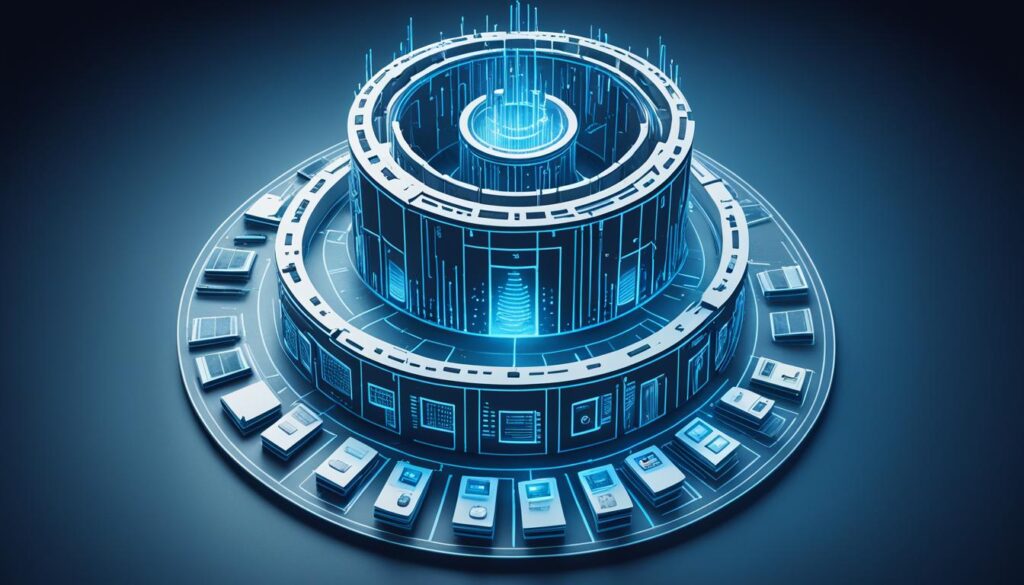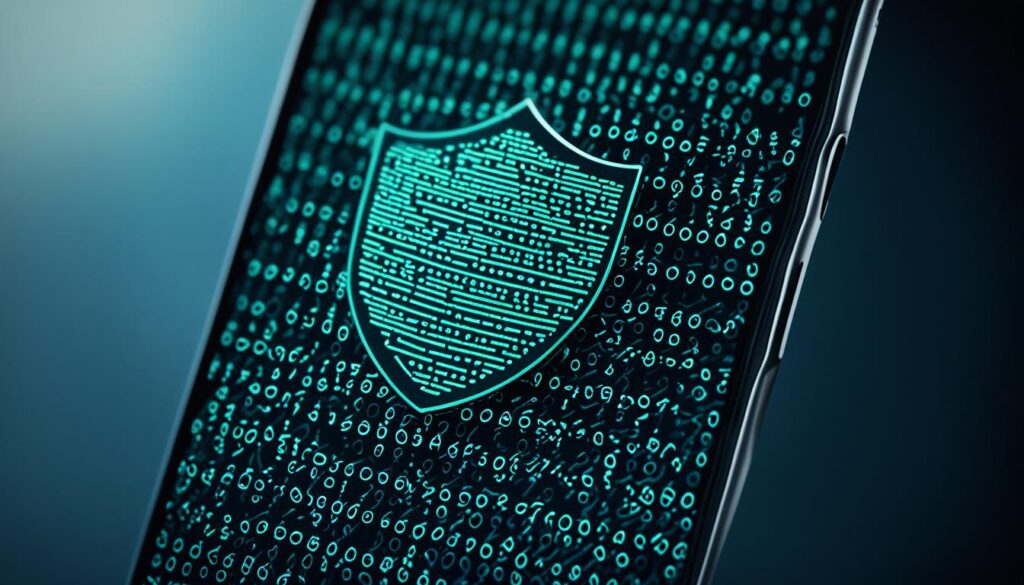Welcome to our article on the emerging cybersecurity threats that you need to be aware of in 2024. As technology continues to advance, so do the tactics and strategies employed by cybercriminals. In this rapidly evolving landscape, it is crucial for individuals and organizations to stay informed about these impending threats to effectively protect their digital assets and maintain a secure online presence.
Throughout this article, we will explore the future cyber risks that experts anticipate will pose significant challenges in 2024. From AI-powered mayhem to the evolution of phishing attacks, we will dive into various cybersecurity trends that you should be prepared for. Additionally, we will discuss the importance of network security in safeguarding against these emerging threats.
Cyber attacks in 2024 are expected to become even more sophisticated, exploiting vulnerabilities in technologies and human behavior. By understanding these threats and implementing the right security measures, you can mitigate risks and protect yourself or your organization from potential harm.
Key Takeaways:
- Stay informed about emerging cybersecurity threats in 2024
- Prepare for AI-powered mayhem and the potential manipulation of election processes
- Ransomware-as-a-Service is on the rise, understand encryption-less tactics and the role of initial access brokers
- Phishing attacks are evolving and becoming more sophisticated, be vigilant and employ countermeasures
- Ensure the security of your Internet of Things (IoT) devices through standardization and blockchain technology
Cybersecurity Threats in 2024: AI-Powered Mayhem
The year 2024 promises to bring forth a new era of cybersecurity threats, driven by the power of artificial intelligence. As AI technology continues to advance, so do the tactics employed by malicious actors to wreak havoc in the digital realm. In this section, we will explore the looming dangers posed by AI-powered cyber threats and the potential consequences they may have on individuals and organizations.
The Advent of Generative AI-Driven Attacks
One of the most concerning developments in the realm of cybersecurity is the rise of generative AI-driven attacks. Through sophisticated algorithms, AI-powered cyber adversaries can autonomously generate malicious code, crafting increasingly complex and elusive threats that traditional defenses may struggle to detect. These attacks have the potential to exploit vulnerabilities in software, networks, and even human behavior, making them a significant concern for cybersecurity professionals and individuals alike.
Manipulation of Election Processes with AI Technologies
The impact of AI technologies on election processes is another area of concern in 2024. With the power to analyze vast amounts of data and simulate human behavior, AI can be utilized to manipulate public opinion, influence voting patterns, and disrupt the democratic process. Ensuring the integrity of electoral systems becomes paramount as political campaigns increasingly utilize AI-driven tactics to sway the outcome of elections. The ability to detect and mitigate such threats will be vital to safeguarding the democratic process.
The Role of AI in Future Cyber Resilience Strategies
While AI presents new challenges in the realm of cybersecurity, it also holds the potential to enhance our defenses and resilience. AI-powered cybersecurity technologies can analyze vast amounts of data in real-time, detecting anomalies, identifying patterns, and enabling rapid response to emerging threats. By leveraging AI, organizations can develop proactive cyber defense strategies that adapt to evolving attack techniques, bolstering their resilience in the face of sophisticated cyber threats.
As we move into 2024, it is essential for individuals, organizations, and cybersecurity professionals to stay updated regarding the risks posed by AI-powered cyber threats. By understanding these emerging threats and harnessing the potential of AI-driven defense mechanisms, we can better protect ourselves and the digital ecosystem from the mayhem that awaits.
Top 12 Generative AI Tools for 2024: Unleash Your Creativity with The Best Generative AI Tools
Ransomware-as-a-Service: The New Normal in Cyber Extortion
This section will focus on the rise of ransomware-as-a-service as the new normal in cyber extortion in 2024. Ransomware-as-a-service (RaaS) refers to the distribution of ransomware by cybercriminals who provide it as a service to other malicious actors. This approach allows even individuals with limited technical expertise to carry out ransomware attacks, making it a widespread threat in the cybersecurity landscape.
One concerning aspect of ransomware-as-a-service is the utilization of encryption-less ransomware tactics. Traditionally, ransomware encrypts the victims’ files, rendering them inaccessible until a ransom is paid. However, encryption-less ransomware forgoes this step, focusing instead on acquiring sensitive data and threatening its release unless a ransom is paid. This tactic poses a significant risk as it bypasses traditional methods of anomaly detection that rely on detecting encrypted files.
The growing popularity of ransomware-as-a-service has also fueled the emergence of a thriving market for initial access brokers. These brokers play a crucial role in cyber extortion schemes by selling unauthorized access to compromised networks and providing a stepping stone for ransomware deployment. The increasing accessibility of initial access brokers on the dark web has facilitated the quick and convenient acquisition of network access for malicious purposes.
| Ransomware Market Trends | Implications |
|---|---|
| Increasing demand for ransomware-as-a-service | – Higher risk of ransomware attacks targeting individuals and organizations – Widening pool of potential attackers |
| Adoption of encryption-less ransomware tactics | – Enhanced difficulty in detecting ransomware attacks – Shift in focus from file encryption to data exfiltration |
| Rising prominence of initial access brokers | – Easier access to compromised networks for ransomware deployment – Facilitation of unauthorized network access for malicious actors |
As ransomware-as-a-service becomes more prevalent, organizations and individuals must be vigilant in implementing robust cybersecurity measures. This includes employing anomaly detection techniques that can identify encryption-less ransomware tactics and investing in proactive strategies to prevent unauthorized access to their networks. Additionally, maintaining up-to-date backups of critical data can help mitigate the impact of a ransomware attack.
The Evolution of Phishing: Crafted by AI, Delivered at Scale
In today’s digital landscape, phishing attacks have become increasingly sophisticated, thanks to the integration of artificial intelligence (AI) technology. Cybercriminals are leveraging AI-powered tools and techniques to deploy highly targeted and effective phishing campaigns at an unprecedented scale. As a result, individuals and organizations must be aware of the evolving tactics employed by these malicious actors in order to protect themselves from falling victim to such attacks.
AI-powered phishing attacks employ machine learning algorithms to analyze vast amounts of data and generate highly personalized and convincing phishing emails. By utilizing AI, cybercriminals can craft emails that mimic the writing style and patterns of legitimate senders, making them difficult to detect. These spear-phishing emails are specially curated to exploit the recipient’s trust and convince them to divulge sensitive information or perform actions that benefit the attacker.
Furthermore, AI technology allows for intricate social engineering techniques that exploit human emotions and cognitive biases, making the phishing emails appear even more legitimate. Machine learning algorithms can collect and analyze vast amounts of data from social media and other online sources to create tailored phishing messages that exploit individual characteristics and preferences, increasing the likelihood of a successful attack.
Additionally, AI-powered phishing campaigns are capable of adapting and evolving in real-time. These attacks can automatically adjust their tactics and messages based on the recipient’s responses, improving their effectiveness over time. Through continuous learning and optimization, AI-powered phishing campaigns can bypass traditional email filters and security measures, posing a significant threat to individuals and organizations alike.
“The integration of AI technology in phishing attacks has fundamentally changed the threat landscape. Cybercriminals now have the ability to craft highly convincing and targeted phishing emails, drastically increasing the success rates of their attacks.” – Cybersecurity Expert
To combat the growing threat of AI-powered phishing attacks, individuals and organizations must implement robust security measures. This includes:
- Regularly updating and patching software and operating systems to mitigate vulnerabilities that can be exploited by phishing attacks.
- Deploying spam filters and email gateways with advanced AI algorithms to detect and block malicious emails.
- Implementing multi-factor authentication (MFA) to add an extra layer of security and prevent unauthorized access to accounts.
- Providing comprehensive cybersecurity training and awareness programs to educate employees about the risks of phishing attacks and how to identify and report suspicious emails.
By staying informed about evolving phishing techniques and employing effective countermeasures, individuals and organizations can significantly reduce the risk of falling victim to AI-powered phishing attacks.

Securing the Internet of Things Against Emerging Risks
This section focuses on the emerging risks associated with the Internet of Things (IoT) in 2024. To mitigate these vulnerabilities, standardizing IoT security protocols is of utmost importance. Additionally, blockchain technology has the potential to act as a shield for IoT networks, offering enhanced security and trust.
Standardization of IoT Security Protocols
In order to secure the vast and interconnected world of IoT devices, the standardization of security protocols is crucial. With a standardized approach, IoT devices can adhere to a common set of security practices, ensuring consistency and reducing vulnerabilities. By establishing a uniform framework for IoT security, organizations and manufacturers can enhance the overall security posture of IoT ecosystems.
Blockchain as a Shield for IoT Networks
Blockchain technology holds great promise in fortifying the security of IoT networks. By leveraging the decentralized and immutable nature of blockchain, IoT devices can be protected against unauthorized access and tampering. Blockchain can provide secure identity verification, data integrity, and secure communication channels within the IoT ecosystem. Through its distributed ledger, blockchain enhances transparency, trust, and resilience, making it an ideal solution for IoT security.

Adapting to the Quantum Leap: Preparing for Quantum Computing’s Impact
Quantum computing is set to revolutionize the technological landscape, offering immense computing power and capabilities that traditional computers cannot match. While this advancement brings tremendous opportunities, it also poses significant challenges for cybersecurity. In this section, we will explore the impact of quantum computing on cybersecurity in 2024 and the need for adaptation.
Post-Quantum Cryptography: The Race Against Time
As quantum computing continues to progress, the threat it poses to existing cryptographic systems becomes increasingly imminent. Traditional encryption algorithms that currently safeguard sensitive data will be vulnerable to attacks from quantum computers, rendering them obsolete. To mitigate this risk, the adoption of post-quantum cryptography is crucial.
Post-quantum cryptography refers to cryptographic algorithms and protocols that can withstand attacks from quantum computers. These algorithms rely on mathematical techniques that are resistant to quantum computing’s computational power. As organizations race against time to transition to post-quantum cryptography, it is essential to ensure the security and privacy of data in the quantum era.
Quantum Computing’s Dual-edged Sword for Cybersecurity

Quantum computing not only poses challenges but also presents unique opportunities for cybersecurity. Its potential to solve complex mathematical problems at an extraordinary speed can be harnessed to enhance cybersecurity defenses. Quantum-resistant encryption algorithms can be developed and deployed, safeguarding sensitive information from quantum-based attacks.
However, it is important to note that quantum computers can also be utilized by adversaries to break existing encryption systems and compromise sensitive data. This dual-edged sword nature of quantum computing necessitates a proactive approach to cybersecurity. Organizations must stay ahead of the curve by investing in research and development, collaborating with experts, and implementing robust security measures.
In conclusion, the advent of quantum computing brings both benefits and challenges for cybersecurity. The urgency of post-quantum cryptography cannot be understated, as it is the key to maintaining data security in the face of quantum-based attacks. By embracing quantum computing’s potential while addressing its risks, organizations can ensure a secure digital future.
Zero Trust Architecture: Building Immunity in Network Security
In today’s rapidly evolving cybersecurity landscape, traditional perimeter-based security models are no longer sufficient to protect against advanced threats. To combat the increasing sophistication of cyber attacks, organizations are turning to a new approach known as zero trust architecture.
In a zero trust model, the fundamental principle is to distrust everything, regardless of location, and verify every user and device trying to access the network. This means that users and devices are never automatically granted trust based on their location or network credentials.

By adopting a zero trust architecture, organizations can significantly enhance their network security immunity. This approach ensures that all users and devices, whether within or outside the network perimeter, are continuously authenticated, authorized, and monitored.
Start earning effortlessly! Claim your $3 bonus and monetize your unused data with Honeygain. It’s simple, secure, and smart.
Claim Nowand watch your balance grow! 🍯💸
Zero trust architecture operates on the principle of least privilege, granting users and devices only the permissions necessary to perform their specific tasks. This minimizes the potential attack surface and reduces the risk of unauthorized access or lateral movement within the network.
Implementing zero trust architecture requires a comprehensive approach that includes network segmentation, strict access control policies, multifactor authentication, continuous monitoring, and encryption. Additionally, advanced technologies such as artificial intelligence and machine learning can be leveraged to detect and respond to anomalous behavior in real-time.
By embracing zero trust architecture, organizations can establish a proactive and layered defense strategy that adapts to the evolving threat landscape. This approach not only improves network security but also provides greater visibility and control over user activities and data access, enhancing regulatory compliance.
The traditional perimeter-based security model is no longer sufficient in today’s cybersecurity landscape. Zero trust architecture takes a more proactive and granular approach, verifying users and devices at every interaction, regardless of their location. This ensures a robust and resilient network security infrastructure.
Benefits of Zero Trust Architecture:
- Enhanced network security immunity against advanced threats
- Reduced attack surface and risk of unauthorized access
- Improved visibility and control over user activities
- Greater regulatory compliance
- Adaptive defense that evolves with the threat landscape
Key Components of Zero Trust Architecture:
- Network segmentation to partition the network and restrict lateral movement
- Strict access control policies based on least privilege
- Multifactor authentication to verify user identities
- Continuous monitoring and anomaly detection for real-time threat response
- Encryption to protect sensitive data in transit and at rest
In conclusion, adopting a zero trust architecture is vital for organizations seeking to bolster their network security immunity. By implementing stringent access controls, continuous monitoring, and advanced authentication mechanisms, organizations can establish a robust defense against emerging cyber threats. By embracing the principles of zero trust, organizations can build an immune network security architecture that mitigates the risks posed by evolving cyber threats.
Mobile Device Threats: Addressing Security in a Connected World
In today’s connected world, mobile devices have become an essential part of our everyday lives. However, with increased connectivity comes increased security risks. It is vital to understand and address the potential threats to mobile device security, ensuring the protection of personal and sensitive information.
The Crucial Role of Encryption & MFA in Mobile Security
Encryption serves as a fundamental safeguard in mobile device security. By converting data into an unreadable format, encryption ensures that even if the device is compromised, the data remains inaccessible to unauthorized individuals. It adds an extra layer of protection, making it much more challenging for cybercriminals to intercept and exploit sensitive information.
Additionally, implementing multi-factor authentication (MFA) significantly enhances mobile device security. MFA requires users to provide multiple forms of identification, such as a password, biometric authentication, or a verification code, to gain access to their devices. This approach adds an extra layer of protection, mitigating the risk of unauthorized access even if an individual’s password is compromised.
Enabling Secure Mobile Access with User-friendly Solutions
While prioritizing mobile device security is crucial, it is equally important to ensure that security solutions are user-friendly and do not hinder the overall user experience. User-friendly security solutions make it easier for individuals to adopt secure practices and reduce the likelihood of them bypassing security measures for convenience.
By utilizing intuitive interfaces, streamlined authentication processes, and seamless integrations, user-friendly security solutions provide a balance between convenience and robust security. These solutions empower individuals to protect their devices and sensitive data without compromising the usability and accessibility of their mobile devices.

Regulation-induced Cyber Threat Shifts: How the SEC Is Shaping Strategies
In this section, we will examine how cyber threats are shifting in response to cybersecurity regulations, with a specific focus on the impact of the SEC (U.S. Securities and Exchange Commission). As the regulatory landscape evolves, organizations are facing new challenges in securing their digital assets and protecting sensitive information.
Legal Implications of New Cyber Regulations
The implementation of cybersecurity regulations introduces various legal implications that organizations must consider. Compliance requirements, data breach notification laws, and privacy regulations create a complex environment that demands proactive measures to ensure adherence. Failure to comply may result in severe penalties and reputational damage.
SEC Cyber Disclosure Rules Prompting Stealthier Hacks
The SEC’s cyber disclosure rules have had an unintended consequence of prompting cybercriminals to adopt stealthier hacking techniques. With organizations now required to disclose cybersecurity incidents and vulnerabilities, hackers are finding innovative ways to exploit weaknesses without triggering detection. This shift highlights the importance of robust cybersecurity strategies and continuous monitoring to counter emerging threats.
10 AI Tools for Teachers in 2024: Harnessing ChatGPT and More!
Conclusion
In conclusion, staying ahead of emerging cybersecurity threats is crucial in today’s rapidly evolving digital landscape. By strengthening our cyber defenses, we can protect our valuable digital assets and maintain a secure online presence.
One of the key strategies for strengthening cyber defenses is fostering cross-functional collaboration in cybersecurity. By involving individuals from various departments and disciplines, organizations can gain a holistic understanding of potential risks and implement robust security measures.
Furthermore, future-proofing our cybersecurity strategies is essential to adapt to the ever-changing threat landscape. This involves regularly updating our security protocols, leveraging advanced technologies, and staying informed about the latest trends in cyber attacks. By taking a proactive approach, we can better protect ourselves against emerging risks.
In summary, by prioritizing the strengthening of our cyber defenses, fostering cross-functional collaboration, and future-proofing our cybersecurity strategies, we can mitigate the risks posed by emerging cyber threats and maintain a resilient digital infrastructure. Remember, cybersecurity is a collective effort, and every individual and organization plays a crucial role in creating a safer online environment.

